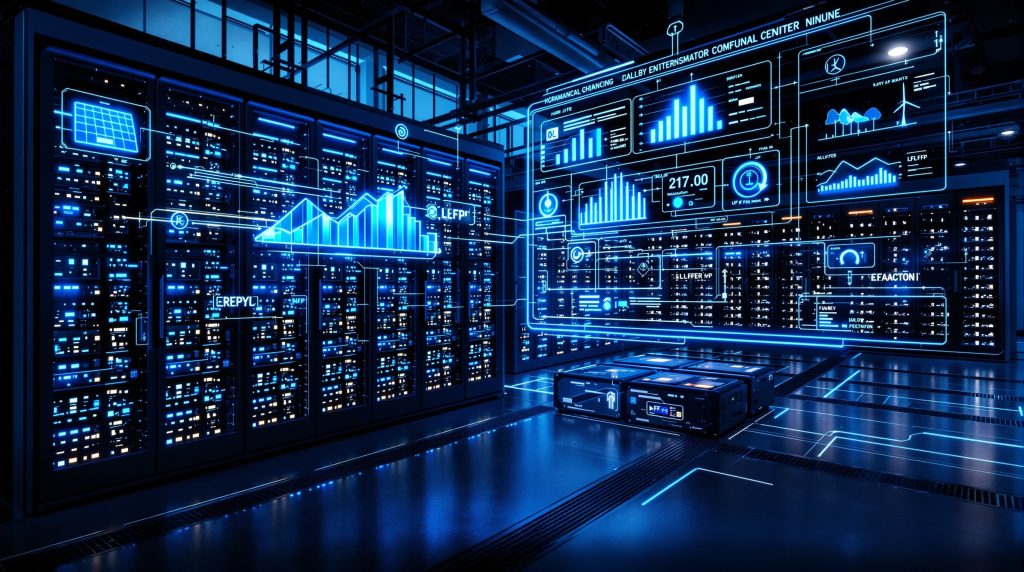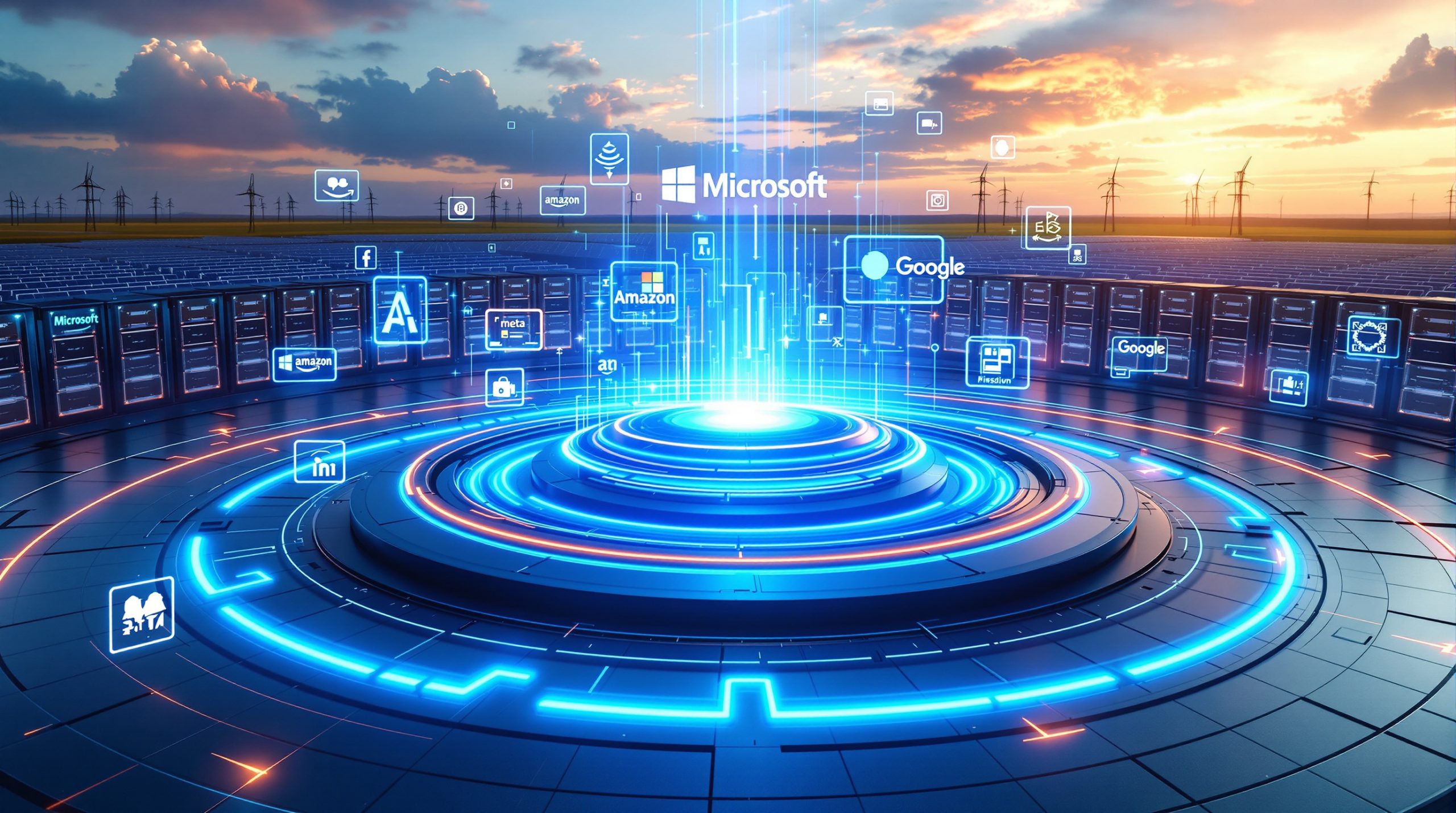Energy Storage Systems for AI Data Centers: Powering the Future of Computing Key Components of Data Center Energy Storage Energy storage systems for AI data centers represent specialized power management solutions engineered to address the unique energy demands of artificial intelligence computing infrastructure. These systems fulfill multiple crucial functions, including power stabilization, backup power provision, and enabling more efficient renewable energy utilization. The core components of these systems include Battery Energy Storage Systems (BESS), which primarily utilize lithium-ion, LFP, and emerging battery chemistries. These work alongside sophisticated power management systems—both software and hardware—that control energy flow and optimization across the facility. Equally important are thermal management solutions that regulate temperature for optimal battery performance and the integration infrastructure that connects storage systems to both the grid and data center power systems. The Evolution of Energy Storage for Computing The development of energy storage for computing has progressed through distinct generations. First-generation systems (2010-2015) featured basic UPS systems with limited capacity and runtime. Second-generation solutions (2015-2020) introduced dedicated battery systems with improved energy density. Current generation systems (2020-Present) showcase advanced integrated platforms with AI-driven management capabilities that can anticipate and respond to complex power needs. Why Are Energy Storage Systems Critical for AI Infrastructure? The Unprecedented Power Demands of AI Computing AI data centers consume significantly more power than traditional computing facilities. Recent industry analysis indicates that AI workloads require 10-15 times more energy than standard cloud computing tasks. Modern AI training clusters can demand between 20-50 MW of continuous power, with demand spikes reaching 2-3 times baseline during intensive computational phases. This unprecedented energy consumption creates challenges for both data center operators and utility providers, necessitating new approaches to power management and storage. Grid Stability Challenges The rapid growth of AI computing is placing extraordinary strain on power grids worldwide. According to recent projections, by 2025, AI data center power demand could reach 15-20 GW in North America (requiring 8-12% grid capacity increase), 8-12 GW in Europe (5-8% increase needed), and 25-30 GW in Asia-Pacific (demanding 10-15% additional capacity). As noted by industry expert Ken Hoffman, "The global grid is being crushed by AI. The need for battery ESS [BESS] is massive – every power-dependent activity needs backup power" (Fastmarkets, September 2025). This assessment reflects growing concerns about grid reliability, with real-world examples like the April 2025 Iberian peninsula power outage highlighting vulnerabilities in existing infrastructure. Business Continuity Requirements AI operations require continuous, uninterrupted power to prevent several critical problems. Data loss during training phases can set back projects by weeks and waste millions in computing resources. Service disruptions for deployed AI systems can impact thousands of downstream business operations. Hardware damage from improper shutdowns can destroy expensive specialized processors and accelerators that often face months-long backorder times. How Do Battery Energy Storage Systems Support AI Data Centers? Managing Peak Power Demands BESS solutions enable data centers to implement peak shaving strategies, reducing the need for grid upgrades while lowering operational costs. Load leveling allows batteries to discharge during high-demand periods and recharge during low-demand periods, creating a more consistent power profile. Demand response capabilities permit storage systems to reduce grid draw during critical periods, supporting both grid stability and often generating revenue through utility incentive programs. Power quality improvement features stabilize voltage and frequency fluctuations that could otherwise damage sensitive AI hardware. Enabling Renewable Energy Integration Energy storage systems bridge the gap between intermittent renewable generation and the constant power needs of AI infrastructure. Time-shifting capabilities store renewable energy when generated for use when needed, allowing facilities to maximize renewable utilization without sacrificing reliability. Capacity firming smooths out the variability in renewable generation, creating a more consistent power profile from inconsistent sources. Microgrid support enables isolated operation with renewable sources when needed, creating resilience against grid failures. Providing Critical Backup Power Modern AI data centers require more sophisticated backup solutions than traditional UPS systems. Extended runtime capabilities support operations for hours rather than minutes, bridging longer outages or grid instability events. Seamless transition features eliminate even millisecond disruptions that can impact AI workloads and cause processing errors or data corruption. Scalable capacity through modular designs allows for expansion as computing needs grow, ensuring backup power scales with facility requirements. As industry experts note, "every power-dependent activity needs backup power" and the sector is responding by improving "pack capacities, with power densities likely to soar" (Fastmarkets, September 2025). What Battery Technologies Power AI Data Center Storage? Lithium-Ion vs. LFP Chemistry Comparison The battery technologies powering AI data centers offer different advantages depending on specific facility needs. Traditional lithium-ion NMC (nickel manganese cobalt) batteries provide higher energy density (200-300 Wh/kg) but typically offer 1,000-2,000 cycles of useful life at a higher cost point. They require sophisticated management systems to ensure safety. In contrast, Lithium Iron Phosphate (LFP) batteries deliver lower energy density (90-160 Wh/kg) but offer significantly longer lifespans of 3,000-5,000 cycles at lower cost points. Their excellent thermal stability makes them particularly attractive for data center applications where safety is paramount. According to industry analysis, "ESS is leading the way in a surge in battery demand in China, which has been led by the use of LFP batteries" (Fastmarkets, September 2025), indicating a growing preference for this chemistry in stationary applications. Emerging Battery Technologies for Data Centers Beyond current mainstream options, several emerging technologies show promise for data center applications. Solid-state batteries offer potentially higher energy density and improved safety profiles by eliminating liquid electrolytes. Flow batteries provide longer duration storage with lower degradation, making them suitable for extended backup needs. Sodium-ion batteries are gaining attention for reducing dependency on lithium market dynamics and supply chains, offering potentially more sustainable and geopolitically secure options. Industry forecasts suggest "a shift toward increased use of manganese-rich batteries, using lithium-manganese-iron phosphate chemistries" that may "gain more market share than the currently dominant nickel-manganese-cobalt chemistry in Europe" (Fastmarkets, September 2025). How Are Energy Storage Systems Transforming AI Data Center Design? Distributed Power Architecture Modern AI facilities are moving away from centralized power systems toward more resilient distributed approaches. Pod-based designs feature dedicated storage systems for specific computing clusters, allowing for targeted power management based on workload types and criticality. Rack-level integration places battery systems directly into computing racks, minimizing transmission distances and losses while providing immediate backup to specific hardware. Hybrid approaches combine centralized and distributed storage for different needs, balancing efficiency and redundancy based on workload requirements. Thermal Management Integration Energy storage systems are increasingly integrated with cooling infrastructure to maximize efficiency and minimize wasted energy. Waste heat utilization systems capture and repurpose heat generated by batteries during cycling, contributing to facility heating or other thermal needs. Combined cooling solutions share liquid cooling systems between computing and storage components, reducing overall cooling infrastructure costs and complexity. Temperature optimization systems maintain ideal operating conditions for both computing and battery systems, maximizing performance and lifespan of all components. What Are the Economic Benefits of Energy Storage for AI Operations? Cost Optimization Strategies Energy storage enables multiple cost-saving approaches for AI data centers. Energy arbitrage allows facilities to purchase and store energy when prices are low (typically overnight) and use stored energy when prices are high (peak daytime hours), reducing overall energy costs. Demand charge reduction helps facilities avoid peak utility rates through strategic battery discharge during high-demand periods, which can reduce monthly utility bills by 15-30% in many markets. Infrastructure deferral capabilities postpone costly grid connection upgrades by managing peak demands internally, saving millions in capital expenditures. Industry experts emphasize that "cell companies need to reduce their costs while they increase densities" to remain competitive (Fastmarkets, September 2025), highlighting the dual focus on cost reduction and performance improvement. ROI Analysis for Different Deployment Scenarios Return on investment varies significantly based on deployment strategy. Peak shaving deployments typically require initial investments of $500-800/kWh with payback periods of 4-6 years and 15-25% TCO savings over a decade. Renewable integration projects generally cost $600-900/kWh with 5-7 year payback periods and 20-30% TCO savings. Full resilience solutions that address multiple needs simultaneously require higher initial investments of $700-1,000/kWh but offer faster 3-5 year payback periods and 25-40% TCO savings over ten years due to their comprehensive benefits. How Are Industry Leaders Implementing Energy Storage? Case Studies of Successful Deployments Microsoft's Carbon-Negative Data Centers Microsoft has implemented large-scale BESS solutions that enable 24/7 renewable energy utilization across their global data center fleet. These systems provide grid services that generate additional revenue through frequency regulation and capacity markets, creating new value streams beyond traditional backup functions. The company has achieved complete diesel generator elimination at select facilities, replacing traditional backup power with battery systems that offer faster response times and zero local emissions. This approach aligns with their sustainability goals while also improving reliability for AI workloads. Google's Grid-Interactive Approach Google has pioneered advanced energy storage systems for AI data centers that provide grid stabilization services in multiple markets. Their approach supports local utility infrastructure by helping balance supply and demand during peak periods. The company employs dynamic power management based on AI workload forecasting, using machine learning to predict computational needs and optimize battery cycling accordingly. This intelligent approach maximizes battery lifespan while minimizing operational costs. What Are the Environmental Implications of AI Data Center Storage? Sustainability Impact Assessment Energy storage systems significantly reduce the environmental footprint of AI operations through several mechanisms. Carbon reduction comes from enabling higher renewable energy utilization, allowing facilities to use intermittent clean energy more effectively throughout the day. Land use efficiency increases by reducing the need for additional power generation facilities, as existing generation can be used more efficiently with storage. Resource conservation occurs by decreasing demand for peaking power plants that often use natural gas or other fossil fuels. Lifecycle Considerations The full environmental impact includes raw material sourcing concerns, particularly ethical considerations for battery minerals including lithium, cobalt, nickel, and manganese. Manufacturing impacts encompass energy and resource requirements for production, which can be substantial depending on battery chemistry and manufacturing location. End-of-life management strategies for battery recycling breakthrough technologies and repurposing are increasingly important as battery deployments grow. Second-life applications can extend useful life by repurposing data center batteries for less demanding applications after they no longer meet computing requirements. What Are the Future Trends in AI Data Center Energy Storage? Technological Innovations on the Horizon Several emerging innovations promise to transform energy storage for AI facilities. AI-optimized battery management systems are learning and adapting to specific workload patterns, maximizing battery performance and lifespan through intelligent cycling strategies. Ultra-fast response storage technologies capable of responding to millisecond power fluctuations are becoming critical for AI hardware protection. Long-duration solutions providing days rather than hours of backup capacity are emerging for facilities in regions with less reliable grid infrastructure. Industry forecasts indicate that "Stationary storage will be the fastest growing sector of energy storage" with expectations that "power densities likely to soar" as the technology evolves (Fastmarkets, September 2025). Integration with Smart Grid Technologies Future systems will feature deeper integration with broader energy ecosystems. Virtual power plant participation will aggregate storage across multiple facilities, creating larger virtual resources that can participate in wholesale energy markets. Grid-forming capabilities will support broader grid stability beyond the data center, helping utilities maintain frequency and voltage during disturbances. Predictive grid interaction systems will anticipate and respond to grid conditions proactively, optimizing both economics and reliability. How Can Organizations Plan for Energy Storage Implementation? Assessment and Planning Framework Organizations should follow a structured approach when implementing energy storage for AI facilities. Workload analysis must understand specific AI power profiles and requirements, identifying peak demands and usage patterns. Site evaluation should assess local grid conditions and renewable opportunities, including utility rate structures and incentive programs. Technology selection processes should match storage technologies to specific needs, considering chemistry, power capabilities, and energy capacity. Phased implementation approaches build flexible systems that can evolve with needs, starting with critical applications and expanding as benefits are validated. Industry experts recommend "starting relatively small and growing incrementally" rather than trying to "build everything at the same time" (Fastmarkets, September 2025). Key Considerations for System Sizing Several factors determine optimal system sizing for AI facilities. Peak power requirements represent the maximum demand during intensive workloads, which may be 2-3x baseline consumption. Duration needs reflect required runtime during grid outages, typically ranging from 30 minutes to 4+ hours depending on location reliability. Cycling patterns indicating expected frequency of charge/discharge cycles impact both system design and battery selection. Expansion capacity planning accommodates future growth, ensuring infrastructure can scale with computing needs. Frequently Asked Questions About AI Data Center Energy Storage How do energy storage systems improve AI data center reliability? Energy storage systems provide uninterrupted power during grid disturbances, preventing the microsecond interruptions that can disrupt AI processing. They prevent voltage sags and frequency fluctuations that can damage sensitive AI hardware or cause computational errors. These systems also enable graceful shutdown procedures during extended outages, protecting both data and equipment. What is the typical lifespan of battery systems in AI data centers? Modern battery systems designed for data center applications typically last 8-12 years, with LFP chemistry offering longer lifespans than traditional lithium-ion. Actual lifespan varies based on cycling patterns, depth of discharge, and operating temperatures. Advanced management systems can extend useful life by 20-30% through intelligent cycling strategies and thermal optimization. How are energy storage systems monitored and maintained? Advanced monitoring systems track battery health metrics including state of charge, temperature, impedance, and cycle count in real-time. Predictive maintenance algorithms identify potential issues before they cause failures, scheduling interventions during planned maintenance windows. Modular designs allow for selective replacement of degraded components without full system downtime. What safety measures are implemented for battery systems in data centers? Modern installations include multi-layered safety systems with thermal runaway prevention through advanced monitoring and cooling. Fire suppression systems specifically designed for battery fires use specialized agents that can penetrate between cells. Gas detection systems identify early warning signs of battery degradation or thermal events. Physical containment features isolate potential thermal events to prevent propagation between modules. Intelligent battery management systems can isolate faulty cells or modules automatically when abnormal conditions are detected. Conclusion: The Critical Role of Energy Storage in AI's Future Energy storage systems have evolved from simple backup power solutions to sophisticated energy management platforms that are essential to the future of AI computing. As artificial intelligence continues to transform industries and societies, the power infrastructure supporting these systems must evolve accordingly. The integration of advanced energy storage technologies enables more sustainable, reliable, and cost-effective AI operations while supporting broader energy transition security goals. Organizations that implement strategic energy storage solutions will gain competitive advantages through improved resilience, reduced operational costs, and enhanced sustainability credentials. As the AI revolution accelerates, energy storage will remain a critical enabling technology that shapes how and where advanced computing can be deployed, ultimately determining the pace and scale of AI innovation worldwide. With advancements in direct lithium extraction and the development of a new battery-grade lithium refinery in India, the supply chain for these critical components is also evolving to meet growing demands. Further Exploration:Readers interested in learning more about energy storage technologies for data centers can also explore related educational content from industry publications that cover the intersection of power infrastructure and computing technologies. Ready to Discover the Next Breakthrough in Critical Minerals? Stay ahead of the market with real-time alerts on significant ASX mineral discoveries through Discovery Alert's proprietary Discovery IQ model, turning complex data into actionable investment insights. Explore how major mineral discoveries have generated substantial returns by visiting our dedicated discoveries page and start your 30-day free trial today.

Essential Energy Storage Systems for AI Data Centres
Discover how advanced energy storage revolutionizes AI data centers, ensuring



